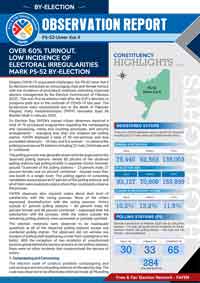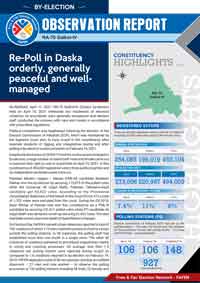ISLAMABAD, February 23, 2021: Free and Fair Election Network (FAFEN) observed an improved quality of electoral processes during the by-elections held from February 16 to 21, 2021, on five provincial and three national assembly constituencies. However, the post-counting events in NA-75 Sialkot-IV, which prompted the Election Commission to withhold the constituency results, overshadowed the improvements.
FAFEN deployed 220 citizen observers—166 men and 54 women—who sent reports from 690 (or 48 percent) of the 1,429 polling stations established across the eight constituencies. These observers had the training to check 180 legal and procedural requirements for the conduct of elections. They witnessed the counting processes at 159 (or 11 percent) of the polling stations.
The observers’ initial reports suggest that an average of 1.7 legal or procedural irregularities took place per polling station across the eight constituencies. On average, 2.2 breaches of the due process occurred per polling station in PB-20 Pishin-III, 1.8 each in PS-43 Sanghar-III and PP-51 Gujranwala, 1.7 each in PS-88 Malir-II and NA-45 Kurram-I, and 1.6 each in NA-75 Sialkot-IV and PK-63 Nowshera-III. The common violations pertained to the illegal campaigning and canvassing in the polling stations’ limits, undue crowding at polling stations, and poor enforcement of COVID-19 protocols.
The management of voting and counting processes inside polling stations saw improvement during the by-elections. However, the incidents of violence outside polling stations, particularly in NA-75 Sialkot, indicate that the Election Commission needs to exercise greater control over the administrative officials. These officials are constitutionally required to assist in conducting free, fair, and transparent elections. Political competitors often indulge in violence to create fear to suppress voting and intimidate election officials from fulfilling their legal responsibilities.
While electoral and political violence incidents had subsided during the last two general elections and in-between by-elections, happenings in NA-75 warrant bold actions by the Election Commission to stop the militarization of future elections. The firing incidents outside the polling stations in NA-75 and the overnight disappearance of presiding officers of 20 polling stations and critical election material, including ballots, resulted from the failure of police and security forces, who were responsible for the safe and prompt delivery of election material to the office of the returning officer. To tackle situations like these, the Commission should consider exercising its powers under Section 55 of the Elections Act, 2017. It should penalize, as per law, all public servants and election officials who are found involved in obstructing polls’ impartial and fair conduct and influencing results. However, FAFEN believes that mere disciplinary action, provided under the law, against election officials and suspension or withdrawal of public servants and persons in Pakistan’s service is not proportionate to the gravity of the offences listed in Section 55(3). These include: “Obstruction, or prevention, or attempts to obstruct or prevent, the conduct of a fair and impartial poll; interference or attempts to interfere with a voter when he casts his vote; influencing or attempts to influence in any manner the polling staff or a voter; any other acts calculated to influence the result of the election; or disobeying any order, or avoiding to carry out any instruction issued by the Commission.”
The Election Commission promptly noticed delays in transmission of 20 polling stations’ results from the presiding officers to the returning officer. It withheld the preliminary constituency result pending an inquiry into the reported disappearance of presiding officers and election material. However, the incident overshadowed the Commission’s gains of improving voting and counting processes’ quality. In the interest of transparency and to inspire greater public confidence, the Election Commission will do well to make public the reasons the relevant returning officers would have cited for delay beyond 2:00 am in receiving results from these polling stations under Section 13(3) of the Election Act, 2017. Similarly, the Commission may also consider ordering a re-poll per its powers under Section 9(1) in polling stations where results got delayed.
Despite the violence in NA-75 Sialkot-IV, the overall quality of voting and counting processes in eight constituencies saw improvement compared to the last general election and subsequent by-elections.
The following are some of the important observation findings:
Campaigning and Canvassing: FAFEN observers observed the party camps in close vicinity of 491 (or 71 percent) of the observed polling stations. The electoral code of conduct prohibits campaigning and canvassing in favour of any party or candidate including the setting up party camps within 400 meters of the polling stations. NA-75 Sialkot-IV had 99 polling stations with party camps in the surroundings, which is the highest among the eight constituencies. It was followed by 74 such polling stations in PK-63, 70 in PS-43, 69 in PP-51, 66 in PS-88, 57 in PB-20, 40 in NA-221, and 16 in NA-45. Moreover, observers noted political workers were persuading the voters to vote for their candidate inside 42 (six percent) polling stations. Fifty-two (eight percent) of polling stations had promotional material of various candidates and political parties inside the building. According to the code of conduct, polling stations should be campaign-free premises.
Polling Stations Setup: A common irregularity across all constituencies was the housing of multiple polling booths in a single room, making the polling stations congested. As many as 159 polling stations (23 percent of the observed or 11 percent of the total polling stations) had more than one polling booth set up in a single room. PS-43 Sanghar-III had 26 such polling stations, PS-88 Malir-II seven, PB-20 Pishin-III 39, NA-45 Kurram Agency-I 14, NA-75 Sialkot-IV 16, PK-63 Nowshera-III 21, and PP-51 Gujranwala-I and NA-221 Tharparkar-I 18 each.
According to the Elections Act, 2017, a polling station may generally be allotted not more than 1200 voters. However, an analysis of the list of polling stations indicated that around 48 percent of the polling stations for these by-elections had more voters than that number. The overcrowding of polling stations can adversely affect the orderly conduct of polling. FAFEN observers also noted a scarcity of election material at 34 (five percent) polling stations.
Electoral Violence: FAFEN observers witnessed 18 incidents of violence in six of the eight constituencies. The seven polling stations where violence occurred were in NA-75 Sialkot-IV, three in NA-45 Kurram Agency-I, and two each in PS-88 Malir-II, PB-20 Pishin-III, PK-63 Nowshera-III, and PP-51 Gujranwala-I. Four of these incidents involved aerial firing outside the polling stations. The rest were verbal or physical clashes among the supporters of various candidates and political parties.
Vote Casting: The polling staff must sign and stamp the back of a ballot paper before issuing it to a voter. A ballot paper without signatures and the official stamp is excluded from the count. FAFEN observers noted that the polling staff was skipping this critical step at four polling stations. Two of these were in PB-20 Pishin-III and one each in PS-43 Sanghar-III and NA-75 Sialkot-IV.
To preserve the voters’ secrecy, ECP installs secrecy screens inside the polling booths so that no one can see voters marking their choices on the ballot papers. However, the observers noted that the secrecy screens at 34 (five percent) polling stations provided no privacy to voters whom the staff could easily see stamping a ballot from outside.
The observers also reported at least one instance of irrelevant individuals accompanying the voters behind the secrecy screens at 13 polling stations. The unauthorized persons were also seen stamping the ballot papers at 12 polling stations.
At 35 (five percent) polling stations, FAFEN observers met voters turned away without being allowed to vote. Fifteen of these polling stations were in PK-63 Nowshera-III, seven in NA-45 Kurram-I, six in PS-43 Sanghar-III, four in PS-88 Malir-II, two in PB-20 Pishin-III, and one in NA-75 Sialkot-IV. At 20 female or combined polling stations, no woman came to vote when the observers were present. Most of these polling stations (11) were in PS-63 Sanghar-III, four in PS-88 Malir-II, two in NA-75 Sialkot-IV, and one each in NA-45 Kurram-I, PK-63 Nowshera-III, and PP-51 Gujranwala-I. Observers reported that the security officials treated the incoming voters with unnecessary rudeness at 14 polling stations.
Counting Process: The observers did not report any violation concerning the counting procedures in any of the eight constituencies. However, the polling staff did not provide copies of Form-45 (Statement of the Count) to polling agents at 11 polling stations and the observers at 23 polling stations. Moreover, 43 presiding officers did not paste the copy of Form-45 outside their polling stations.
Citizen Observation: FAFEN deployed 220 citizen observers—166 men and 54 women—across the eight constituencies. They had the training to check 180 legal indicators of the electoral process. All observers except three in PS-43 Sanghar, NA-45 Kurram Agency-I, and NA-221 Tharparkar were allowed inside the polling stations to observe the polling. However, 15 observers attempting to follow the counting were barred despite having ECP accreditation. Each observer visited up to five polling stations staying at each for an hour before sharing their reports with the FAFEN secretariat on Election Day. Through these observers, FAFEN observed 690 (or 48 percent) of the 1429 polling stations established for these by-elections. The observers witnessed the counting processes at 159 (or 11 percent) polling stations.
To download this report, click here



